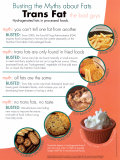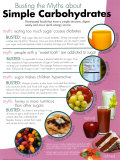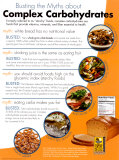|
|
Nutrition Health Educational Posters & Charts, 3 of 3
for the science and cooking classroom, home schoolers, and nutritionists.
|
science > health > nutrition posters 1 | 2 | 3 < culinary / food < social studies
|
|
Nutrition education posters: eating by color of food, myth busting about protein, fat, and carbohydrates.
|
|
“Busting the Myths” about Protein
Poster Text: Most people eat plenty of protein - focus on eating lean. ...
MYTH: protein's main purpose is to build muscles - BUSTED: Proteins are made out of 20 different amino acids that your body can assemble into more than 100,000 different structures. Proteins provide the framework to build and rebuild organs, muscles, antibodies, hormones, and enzymes – every kind of cell in the body.
MYTH: it's difficult for athletes to get enough protein - BUSTED: Sedentary people require 4 grams of protein per 10 pounds of body weight per day, while athletes need about 6 grams of protein per 10 pounds of body weight. Most Americans eat for more protein than either of these recommendations.
MYTH: high protein diets are a healthy way to lose weight - BUSTED: Consuming too much protein, whether from foods, protein supplements or poders can stress your kidneys. Extra water is needed to metabolize excess proteins, and you loose water quickly at first as you become dehydrated. As soon as you re-hydrate, the lost pounds return.
MYTH: protein supplements are good - BUSTED: Commercially prepared or processed powders and bars are a very expensive source of protein. Get protein from: lean beef and pork, poultry, fish, eggs, milk, cheese, yogurt, tofu, beans (black, pinto, lentils, etc.), split peas, cereal, grains, nuts, and seeds.
Moderatelyactive people aged 9 and older need 5 to 6.5 oz. of protein-rich foods daily. In general, a 1-oz. protein equivalent is 1 oz. meat, poultry or fish, 1/4 cup cooked, dry beans or peas, 1/2 oz. nuts or seeds, I Tbsp. peanut butter, 1 egg.
|
|
|
|
“Busting the Myths” about Trans Fat
Poster Text: Trans Fat - the bad guys, hydrogenated fats in processed foods. ...
MYTH: you can't tell one fat from another - BUSTED: Since 2006, the Food & Drug Administration (FDA) requires food companies to list trans fat content separately on the Nutrition Facts label of all packaged foods.
MYTH: trans fats are only found in fried foods - BUSTED: Some trans fats are found naturally in small amounts in meat and dairy products but are not a significant source. Many processed foods use “hydrogenated” vegetable oils that add trans fat, so check the Nutrition Facts label.
MYTH: all fats are the same - BUSTED: Trans fatty acids raise bad cholesterol levels and lower good cholesterol levels, and increase your risk of deveolping heart disease or having a stroke.
MYTH: no trans fats, no taste - BUSTED: Manufactureres arefinding new ways to improve the texture of taste of food without using trans fatty acids.
Scientists began to hydrogenate liquid oils into trans fats in 1903 to provide longer shelf life in manufactured foods.
|
|
|
|
“Busting the Myths” about Simple Carbohydrates
Poster Text: Plant-based foods that have a simple structure, digest easily and are a quick energy source. ...
MYTH: Eating too much sugar causes diabetes. BUSTED: High sugar diets don't cause diabetes. Being overweight is the number one risk factor. However, once you have diabetes, you do need to watch your sugar and carbohydrate intake to properly manage your blood sugar level.
MYTH: People with a “sweet tooth” are addicted to sugar. BUSTED: It's impossible to have a physical addiction to sugar. Over time, exposure to high concentrations of sugr in foods and drinks can increase your sweetness threshod. The average american consumes more than 100 poundsof sugar a year –most hidden in processed foods.
MYTH: Sugar makes children hyperactive. BUSTED: Multiple scientific studies have concluded that children who consume drinks and foods with sugar show no difference in behavior than kids who consume sugar-free products. Sugar does not turn normal children into hyperactive ones.
MYTH: Honey is more nutritious than other sugars. BUSTED: You have to eat at least 1/4 cup of honey to get a small amount of any nutrient other than carbohydrate and causes more tooth decay.
Nutritional sources of simple carbohydrates include fruit, 100% juices, vegetables and milk which all provide vitamins and minerals in addition to their sugar content. Refined sugars are also simple carbohydrates, but they only provide calories, not nutritients.
|
|
|
|
“Busting the Myths” about Complex Carbohydrates
Poster Text: Formerly referred to as “starchy” foods, complex carbohydrates are foods that provide vitamins, minerals, and fiber essential to health. ...
MYTH: White bread has not nutritional value. BUSTED: New whole-grain white breads and cereals are made rom a special 100% whole wheat flour from a white colored varety of wheat. This special grain has a mild taste, sot texture, and all the nutrients of whole grain.
MYTH: Drinking juice is the same as eating fruit. BUSTED: Solid fruits (and vegetables) provide dietary fiber and some antioxidants that are not in juice. While 100% juices are healthful, they are not as nutritious or filling as eating whole fruits.
MYTH: You should avoid foods high on the glycemic index (starchy foods). BUSTED The Glycemic Index (GI) measures how fast carbohydrates from a single food raises bolld sugar levels. While it's a good research tool, the GI doesn't apply to real life since most people eat more than one food or food ingredient at one time.
MYTH: Eating carbs makes you fat. BUSTED: Total carbohydrates should account for 55-60% of the calories you eat. Complex carbohydrates provide a steady , slow energy source and one less likely to be converted to fat.
Don't judge grains by their color. Some dark brown bread and cereal products are just refined grains with added food coloring. Check the nutrion facts panel for the fiber content and choose products with at least one gram of fiber per serving or look for the “whole grain” stamp on the package.
|
|
|

Saturated Fat,
Laminated Poster
no long available
|
“Busting the Myths” about Saturated Fat
Poster Text: Saturated Fat - the not-so-good guys. ... Fats generally found in animal-based foods. ... Saturated fats should be eaten in moderation – 10% of your total intake (1g per 100 calories). ...
|
|
|

Monounsaturated Fat,
Laminated Poster
no long available
|
“Busting the Myths” about Monosaturated Fat
Poster Text: Monounsaturated Fats - the good guys. ... Dark, flavorful oils from plant products. ... Monounsaturated fats originated mostly in the Mediterranean and trace back to ancient times. ...
|
|
|

Polyunsaturated Fat,
Laminated Poster
no long available
|
“Busting the Myths” about Polyunsaturated Fat
Poster Text: Polyunsaturated Fats - the not-so-bad guys. ... Light oils from plant products and fish. ... Polyunsaturated fats as oils have only benn around for the last one hundred years or so. ...
|
|
|

9 Servings a Day, Laminated Poster
no long available
|
9 Servings a Day - Savor the Spectrum Every Day!
Poster Text: Who dreamed up the “9 servings a day” thing? The U.S. Department of Agriculture... The Centers for Disease Control and Prevention are part of it, too. Join a powerhouse team and eat 4 serving (2 cups) of fruits and 5 servings (2 1/2 cups) of vegetables a day, every day! ...
|
|
previous page | nutrition posters 1 | 2 | 3
|
|
I have searched the web for visual, text, and manipulative curriculum support materials - teaching posters, art prints, maps, charts, calendars, books and educational toys featuring famous people, places and events - to help teachers optimize their valuable time and budget.
Browsing the subject areas at NetPosterWorks.com is a learning experience where educators can plan context rich environments while comparing prices, special discounts, framing options and shipping from educational resources.
Thank you for starting your search for inspirational, motivational, and educational posters and learning materials at NetPosterWorks.com. If you need help please contact us.
|
|
|














